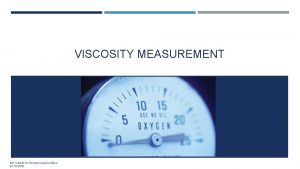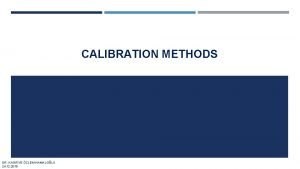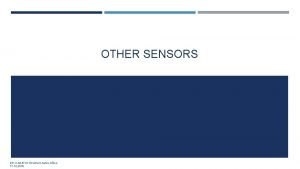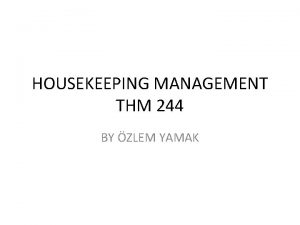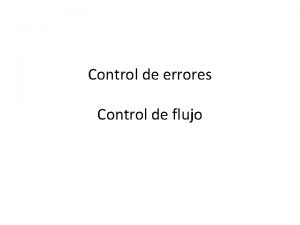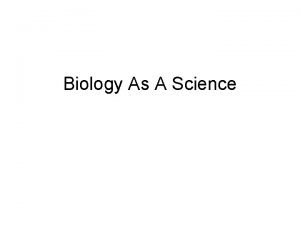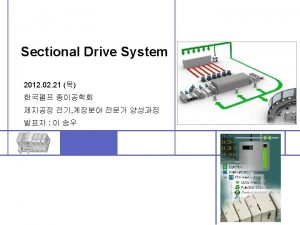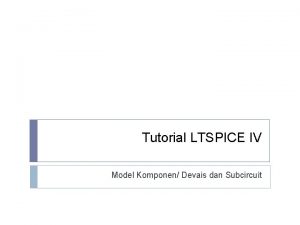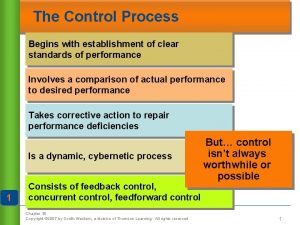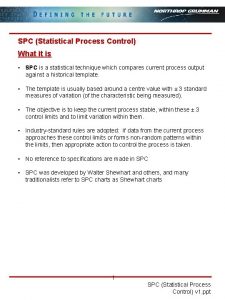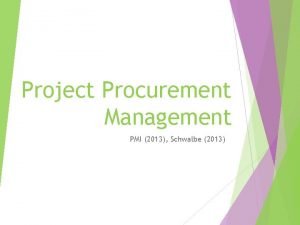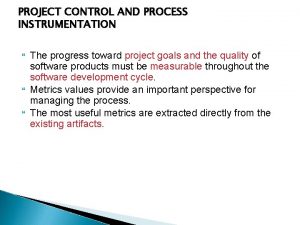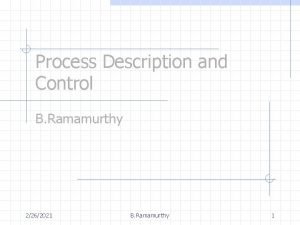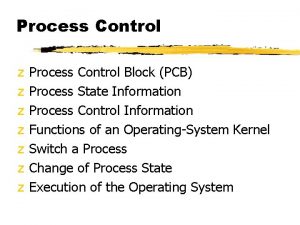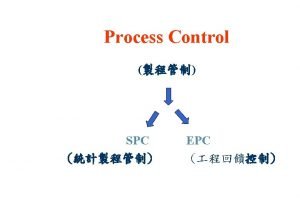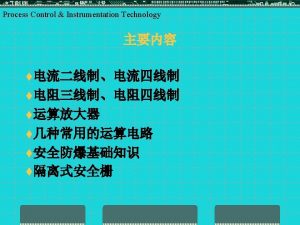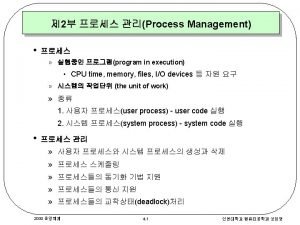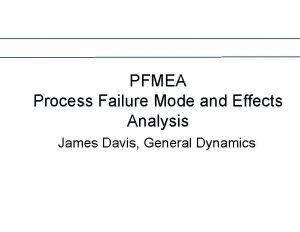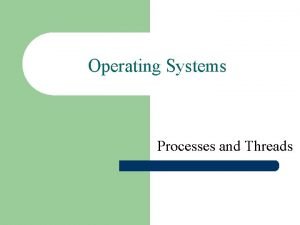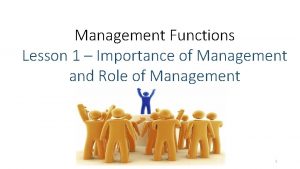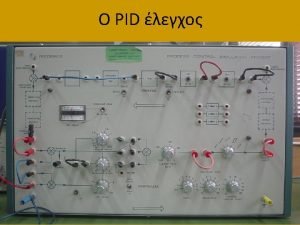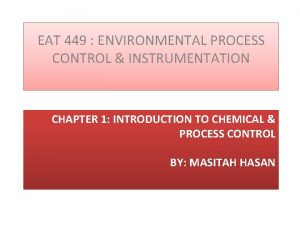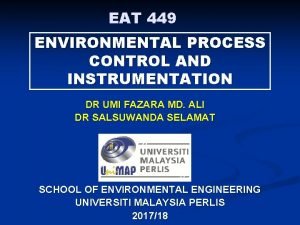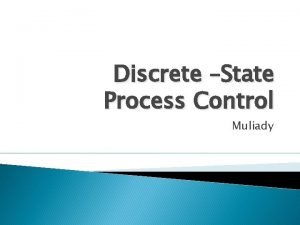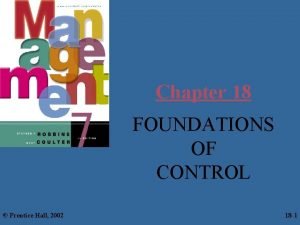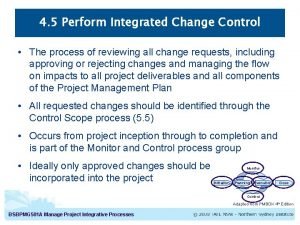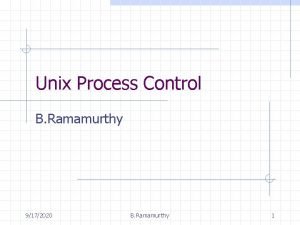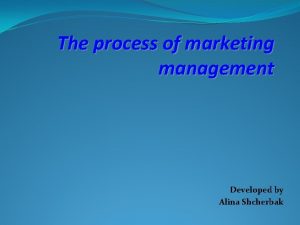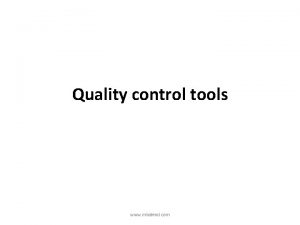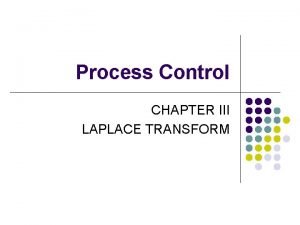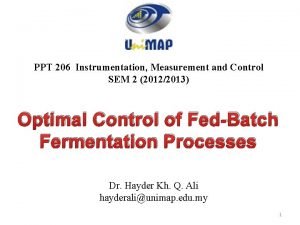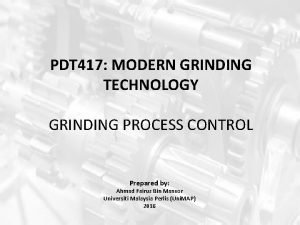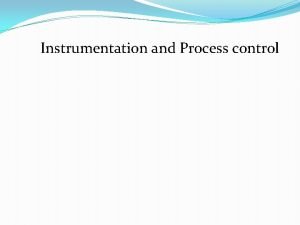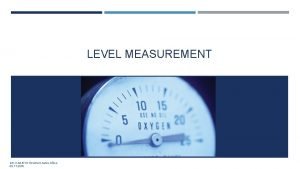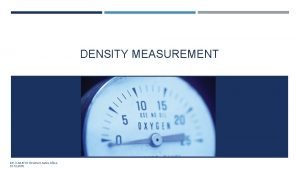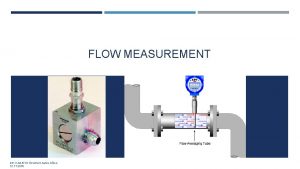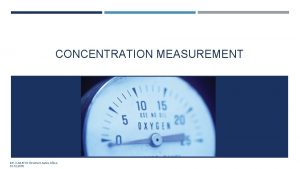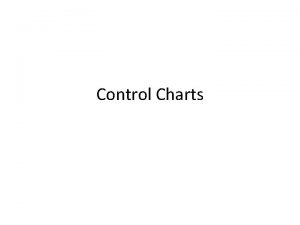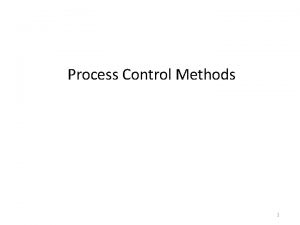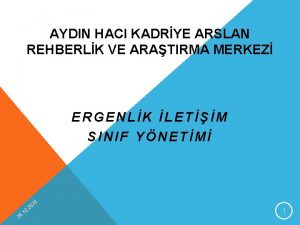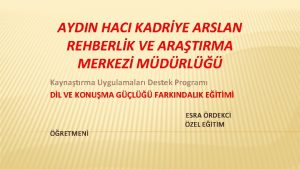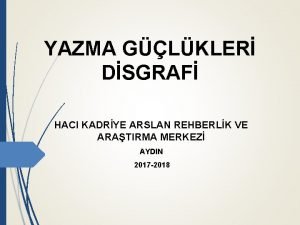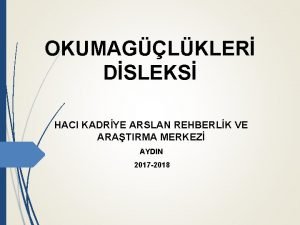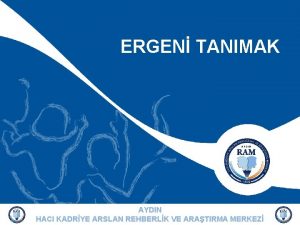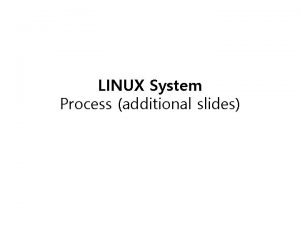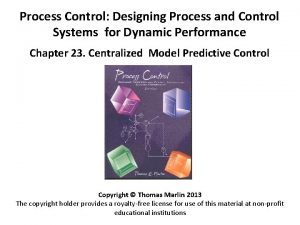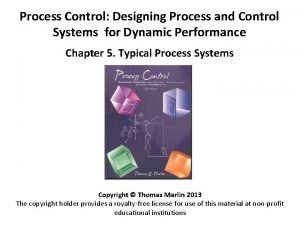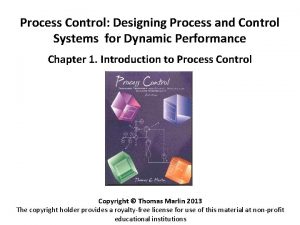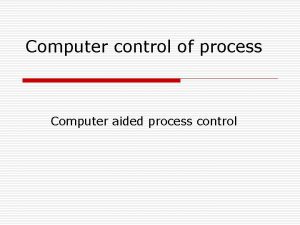PROCESS CONTROL DR KADRYE ZLEM HAMALOLU 24 12












































- Slides: 44

PROCESS CONTROL DR. KADRİYE ÖZLEM HAMALOĞLU 24. 12. 2018

MAIN FEATURES OF PROCESS CONTROL DR. KADRİYE ÖZLEM HAMALOĞLU 24. 12. 2018

HEART OF CHEMICAL PLANT – CONTROL ROOM DR. KADRİYE ÖZLEM HAMALOĞLU 24. 12. 2018

WHY WE NEED PROCESS CONTROL ? • Every Chemical Process requires conversion of feed material to product using different chemical and physical operations. • Strong need to control processes for more efficiency and economically viability has arose due to stronger business competition, tougher environmental and safety regulations and rapidly changing technological trends. • Process Control plays a crucial task in deciding the product quality and has a very high significance in today’s chemical industry. DR. KADRİYE ÖZLEM HAMALOĞLU 24. 12. 2018

BENEFITS OF PROCESS CONTROL • Improves plant performance by reducing the variation of the key variables. • When the variation has been reduced, the desired value of the controlled variable can be adjusted to increase profit. • Process Control provided higher safety to plant and human resource. • Process Control can reduce scrap and waste products and thus would give more profit and longer life for the equipment. • Process control helps in determining inventory in hand so would give almost exact stock position. DR. KADRİYE ÖZLEM HAMALOĞLU 24. 12. 2018

PROCESS CONTROL IN OUR DAILY LIFE Bathroom water heater maintains hot water temperature in safe zone for our comfort. Refrigerator controls temperature of the food items kept in it and avoid their spoilage. Traffic over roads and highways is controlled by traffic light or there can be accidents and jams over the roads. DR. KADRİYE ÖZLEM HAMALOĞLU 24. 12. 2018

What is Process Dynamics ? • Process Dynamics is study of a system in un-steady (or transient) state. • Dynamics study is required to study situations like plant start-ups and shutdowns, unusual process disturbances and planned transitions from one product grade to another. • Dynamics sometimes plays an important part in deciding the control strategies for a process. DR. KADRİYE ÖZLEM HAMALOĞLU 24. 12. 2018

DYNAMICS OF PROCESS - BUS AND BICYCLE Though, a bus and a bicycle may move with same speed, but they will follow different trajectory at a turn on the road. Therefore, study at the transient state is necessary to develop a successful control strategy. DR. KADRİYE ÖZLEM HAMALOĞLU 24. 12. 2018

PROCESS Process as used in the terms process control and process industry, refers to the methods of changing or refining raw materials to create end products. The raw materials, which either pass through or remain in a liquid, gaseous, or slurry (a mix of solids and liquids) state during the process, are transferred, measured, mixed, heated or cooled, filtered, stored, or handled in some other way to produce the end product. Process industries include the chemical industry, the oil and gas industry, the food and beverage industry, the pharmaceutical industry, the water treatment industry, and the power industry. DR. KADRİYE ÖZLEM HAMALOĞLU 24. 12. 2018

PROCESS CONTROL Process control refers to the methods that are used to control process variables when manufacturing a product. For example, factors such as the proportion of one ingredient to another, the temperature of the materials, how well the ingredients are mixed, and the pressure under which the materials are held can significantly impact the quality of an end product. Manufacturers control the production process for three reasons: ❑ Reduce variability ❑ Increase efficiency ❑ Ensure safety DR. KADRİYE ÖZLEM HAMALOĞLU 24. 12. 2018

THE CONTROL LOOP • Imagine you are sitting in a cabin in front of a small fire on a cold winter evening. • You feel uncomfortably cold, so you throw another log on the fire. • This is an example of a control loop. • In the control loop, a variable (temperature) fell below the set point (your comfort level), and you took action to bring the process back into the desired condition by adding fuel to the fire. • The control loop will now remain static until the temperature again rises above or falls below your comfort level. DR. KADRİYE ÖZLEM HAMALOĞLU 24. 12. 2018

CLOSED LOOP- OPEN LOOP A closed control loop exists where a process variable is measured, compared to a set point, and action is taken to correct any deviation from set point. An open control loop exists where the process variable is not compared, and action is taken not in response to feedback on the condition of the process variable, but is instead taken without regard to process variable conditions. For example, a water valve may be opened to add cooling water to a process to prevent the process fluid from getting too hot, based on a pre-set time interval, regardless of the actual temperature of the process fluid. DR. KADRİYE ÖZLEM HAMALOĞLU 24. 12. 2018

THREE TASKS • Control loops in the process control industry work in the same way, requiring three tasks to occur: -Measurement -Comparison -Adjustment DR. KADRİYE ÖZLEM HAMALOĞLU 24. 12. 2018

FEED-FORWARD VS FEEDBACK • Feed-forward control: To prevent process upset due to disturbances, by predicting the potential disturbance and performing control in advance. • Feedback control: To compensate the effect of the disturbance by measuring the controlled variable (CV) and then considering the difference for control. ØFeedback control is the most common used in the industries because the disturbances are basically unpredictable. However, feed-forward control is sometimes useful in some special cases. DR. KADRİYE ÖZLEM HAMALOĞLU 24. 12. 2018

CONTROL STRATEGIES -FEEDBACK • Feedback control: To compensate the effect of the disturbance by measuring the controlled variable (CV) and then considering the difference for control. Feedback control is the most common used in the industries because the disturbances are basically unpredictable. However, feed-forward control is sometimes useful in some special cases. DR. KADRİYE ÖZLEM HAMALOĞLU 24. 12. 2018

FEEDBACK LOOP A feedback loop measures a process variable and sends the measurement to a controller for comparison to setpoint. If the process variable is not at setpoint, control action is taken to return the process variable to setpoint. Figure illustrates a feedback loop in which a transmitter measures the temperature of a fluid and, if necessary, opens or closes a hot steam valve to adjust the fluid’s temperature. DR. KADRİYE ÖZLEM HAMALOĞLU 24. 12. 2018

THE FEEDBACK CONTROL LOOP Control Calculation Sensor Final Element DR. KADRİYE ÖZLEM HAMALOĞLU 24. 12. 2018

FEEDBACK CONTROL LOOP DR. KADRİYE ÖZLEM HAMALOĞLU 24. 12. 2018

CONTROL STRATEGIES – FEED-FORWARD • Feed-forward control: To prevent process upset due to disturbances, by predicting the potential disturbance and performing control in advance. DR. KADRİYE ÖZLEM HAMALOĞLU 24. 12. 2018

FEEDFORWARD CONTROL Feedforward control is a control system that anticipates load disturbances and controls them before they can impact the process variable. For feedforward control to work, the user must have a mathematical understanding of how the manipulated variables will impact the process variable. Figure shows a feedforward loop in which a flow transmitter opens or closes a hot steam valve based on how much cold fluid passes through the flow sensor. DR. KADRİYE ÖZLEM HAMALOĞLU 24. 12. 2018

FEEDFORWARD PLUS FEEDBACK Because of the difficulty of accounting for every possible load disturbance in a feedforward system, feedforward systems are often combined with feedback systems. Controllers with summing functions are used in these combined systems to total the input from both the feedforward loop and the feedback loop, and send a unified signal to the final control element. Figure shows a feedforward-plus-feedback loop in which both a flow transmitter and a temperature transmitter provide information for controlling a hot steam valve. DR. KADRİYE ÖZLEM HAMALOĞLU 24. 12. 2018

PROCESS VARIABLE A process variable is a condition of the process fluid (a liquid or gas) that can change the manufacturing process in some way. In the example of you sitting by the fire, the process variable was temperature. In the example of the tank in Figure, the process variable is level. Common process variables include: ❑ Pressure ❑ Flow ❑ Level ❑ Temperature ❑ Density ❑ Ph (acidity or alkalinity) ❑ Liquid interface ❑ Mass ❑ Conductivity DR. KADRİYE ÖZLEM HAMALOĞLU 24. 12. 2018

TANK EXAMPLE Valve ØA separating process Valve Separating tank Valve Pump ØWhat variable should be controlled in this process? • Feed flow rate • Liquid level DR. KADRİYE ÖZLEM HAMALOĞLU 24. 12. 2018 • Tank pressure

MEASURED VARIABLES, PROCESS VARIABLES, AND MANIPULATED VARIABLES • In the temperature control loop example, the measured variable is temperature, which must be held close to 100 °C. • In this example and in most instances, the measured variable is also the process variable. The measured variable is the condition of the process fluid that must be kept at the designated set point. • Sometimes the measured variable is not the same as the process variable. For example, a manufacturer may measure flow into and out of a storage tank to determine tank level. In this scenario, flow is the measured variable, and the process fluid level is the process variable. • The factor that is changed to keep the measured variable at set point is called the manipulated variable. DR. KADRİYE ÖZLEM HAMALOĞLU 24. 12. 2018

MAIN FEATURES OF PROCESS CONTROL – EXAMPLE : TANK Valve ØA separating process Valve Separating tank Valve Pump ØCVs: DR. KADRİYE ÖZLEM HAMALOĞLU 24. 12. 2018 ØMVs: • Feed flow rate • Liquid level • Vapor flow rate • Tank pressure • Liquid flow rate

MAIN FEATURES OF PROCESS CONTROL – EXAMPLE : WATER HEATER Disturbance Variable Water Flow Tap Opening Gas Flow Manipulated Variable DR. KADRİYE ÖZLEM HAMALOĞLU 24. 12. 2018 Temperature Control Variable

SETPOINT The setpoint is a value for a process variable that is desired to be maintained. For example, if a process temperature needs to kept within 5 °C of 100 °C, then the setpoint is 100 °C. A temperature sensor can be used to help maintain the temperature at setpoint. The sensor is inserted into the process, and a contoller compares the temperature reading from the sensor to the setpoint. If the temperature reading is 110 °C, then the controller determines that the process is above setpoint and signals the fuel valve of the burner to close slightly until the process cools to 100 °C. DR. KADRİYE ÖZLEM HAMALOĞLU 24. 12. 2018

ERROR Error is the difference between the measured variable and the set point and can be either positive or negative. In the temperature control loop example, the error is the difference between the 110 °C measured variable and the 100 °C setpoint—that is, the error is +10 °C. The objective of any control scheme is to minimize or eliminate error. Therefore, it is imperative that error be well understood. Any error can be seen as having three major components. Magnitude The magnitude of the error is simply the deviation between the values of the set point and the process variable. The magnitude of error at any point in time compared to the previous error provides the basis for determining the change in error. The change in error is also an important value. Duration refers to the length of time that an error condition has existed. Rate Of Change The rate of change is shown by the slope of the error plot. DR. KADRİYE ÖZLEM HAMALOĞLU 24. 12. 2018

OFFSET, LOAD DISTURBANCE Offset is a sustained deviation of the process variable from the set point. In the temperature control loop example, if the control system held the process fluid at 100. 5 °C consistently, even though the set point is 100 °C, then an offset of 0. 5 °C exists. A load disturbance is an undesired change in one of the factors that can affect the process variable. In the temperature control loop example, adding cold process fluid to the vessel would be a load disturbance because it would lower the temperature of the process fluid. DR. KADRİYE ÖZLEM HAMALOĞLU 24. 12. 2018

FEEDBACK CONTROL LOOP DR. KADRİYE ÖZLEM HAMALOĞLU 24. 12. 2018

PRIMARY ELEMENTS/SENSORS In all cases, some kind of instrument is measuring changes in the process and reporting a process variable measurement. Some of the greatest ingenuity in the process control field is apparent in sensing devices. Because sensing devices are the first element in the control loop to measure the process variable, they are also called primary elements. Examples of primary elements include: ❑ Pressure sensing diaphragms, strain gauges, capacitance cells ❑ Resistance temperature detectors (RTDs) ❑ Thermocouples ❑ Orifice plates ❑ Pitot tubes ❑ Venturi tubes ❑ Magnetic flow tubes ❑ Coriolis flow tubes ❑ Radar emitters and receivers ❑ Ultrasonic emitters and receivers DR. KADRİYE ÖZLEM HAMALOĞLU 24. 12. 2018

PRIMARY ELEMENTS Primary elements are devices that cause some change in their property with changes in process fluid conditions that can then be measured. For example, when a conductive fluid passes through the magnetic field in a magnetic flow tube, the fluid generates a voltage that is directly proportional to the velocity of the process fluid. The primary element (magnetic flow tube) outputs a voltage that can be measured and used to calculate the fluid’s flow rate. With an RTD, as the temperature of a process fluid surrounding the RTD rises or falls, the electrical resistance of the RTD increases or decreases a proportional amount. The resistance is measured, and from this measurement, temperature is determined. DR. KADRİYE ÖZLEM HAMALOĞLU 24. 12. 2018

TRANSDUCERS AND CONVERTERS A transducer is a device that translates a mechanical signal into an electrical signal. For example, inside a capacitance pressure device, a transducer converts changes in pressure into a proportional change in capacitance. A converter is a device that converts one type of signal into another type of signal. For example, a converter may convert current into voltage or an analog signal into a digital signal. In process control, a converter used to convert a 4– 20 m. A current signal into a 3– 15 psig pneumatic signal (commonly used by valve actuators) is called a current-to-pressure converter. DR. KADRİYE ÖZLEM HAMALOĞLU 24. 12. 2018

TRANSMITTERS- SIGNALS A transmitter is a device that converts a reading from a sensor or transducer into a standard signal and transmits that signal to a monitor or controller. Transmitter types include: ❑ Pressure transmitters ❑ Flow transmitters ❑ Temperature transmitters ❑ Level transmitters ❑ Analytic (O 2 [oxygen], CO [carbon monoxide], and p. H) transmitters There are three kinds of signals that exist for the process industry to transmit the process variable measurement from the instrument to a centralized control system. 1. Pneumatic signal 2. Analog signal 3. Digital signal DR. KADRİYE ÖZLEM HAMALOĞLU 24. 12. 2018

RECORDERS A recorder is a device that records the output of a measurement devices. Many process manufacturers are required by law to provide a process history to regulatory agencies, and manufacturers use recorders to help meet these regulatory requirements. In addition, manufacturers often use recorders to gather data for trend analyses. By recording the readings of critical measurement points and comparing those readings over time with the results of the process, the process can be improved. Different recorders display the data they collect differently. Some recorders list a set of readings and the times the readings were taken; others create a chart or graph of the readings. Recorders that create charts or graphs are called chart recorders. DR. KADRİYE ÖZLEM HAMALOĞLU 24. 12. 2018

CONTROLLER A controller is a device that receives data from a measurement instrument, compares that data to a programmed set point, and, if necessary, signals a control element to take corrective action. Local controllers are usually one of the three types: pneumatic, electronic or programmable. DR. KADRİYE ÖZLEM HAMALOĞLU 24. 12. 2018

CORRECTING ELEMENTS/FINAL CONTROL ELEMENTS The correcting or final control element is the part of the control system that acts to physically change the manipulated variable. In most cases, the final control element is a valve used to restrict or cut off fluid flow, but pump motors, louvers (typically used to regulate air flow), solenoids, and other devices can also be final control elements. Final control elements are typically used to increase or decrease fluid flow. For example, a final control element may regulate the flow of fuel to a burner to control temperature, the flow of a catalyst into a reactor to control a chemical reaction, or the flow of air into a boiler to control boiler combustion. In any control loop, the speed with which a final control element reacts to correct a variable that is out of set point is very important. Many of the technological improvements in final control elements are related to improving their response time. DR. KADRİYE ÖZLEM HAMALOĞLU 24. 12. 2018

ACTUATORS An actuator is the part of a final control device change in the final control device when signalled to do so. that causes a physical The most common example of an actuator is a valve actuator, which opens or closes a valve in response to control signals from a controller. Actuators are often powered pneumatically, hydraulically, or electrically. Diaphragms, bellows, springs, gears, hydraulic pilot valves, pistons, or electric motors are often parts of an actuator system. DR. KADRİYE ÖZLEM HAMALOĞLU 24. 12. 2018

INSTRUMENTATION, SYSTEMS, AND AUTOMATION SOCIETY The Instrumentation, Systems, and Automation Society (ISA) is one of the leading process control trade and standards organizations. The ISA has developed a set of symbols for use in engineering drawings and designs of control loops. You should be familiar with ISA symbology so that you can demonstrate possible process control loop solutions. Figure shows a control loop using ISA symbology. Drawings of this kind are known instrumentation drawings (P&ID). DR. KADRİYE ÖZLEM HAMALOĞLU 24. 12. 2018 as piping and

PIPING AND CONNECTIONS Piping and connections are represented with several different symbols ❑ A heavy solid line represents piping ❑ A thin solid line represents process connections to instruments (e. g. , impulse piping) ❑ A dashed line represents electrical signals (e. g. , 4– 20 m. A connections) ❑ A slashed line represents pneumatic signal tubes ❑ A line with circles on it represents data links Other connection symbols include capillary tubing for filled systems (e. g. , remote diaphragm seals), hydraulic signal lines, and guided electromagnetic or sonic signals. DR. KADRİYE ÖZLEM HAMALOĞLU 24. 12. 2018

IDENTIFICATION LETTERS Identification letters on the ISA symbols (e. g. , TT for temperature transmitter) indicate: ❑ The variable being measured (e. g. , flow, pressure, temperature) ❑ The device’s function (e. g. , transmitter, switch, valve, sensor, indicator) ❑ Some modifiers (e. g. , high, low, multifunction) The initial letter indicates the measured variable. The second letter indicates a modifier, readout, or device function. The third letter usually indicates either a device function or a modifier. For example, “FIC” on an instrument tag represents a flow indicating controller. “PT” represents a pressure transmitter. You can find identification letter symbology information on the ISA Web site at http: //www. isa. org. DR. KADRİYE ÖZLEM HAMALOĞLU 24. 12. 2018

DR. KADRİYE ÖZLEM HAMALOĞLU 24. 12. 2018

DR. KADRİYE ÖZLEM HAMALOĞLU 24. 12. 2018

DR. KADRİYE ÖZLEM HAMALOĞLU 24. 12. 2018
 Capillary viscometer
Capillary viscometer Antracyclins
Antracyclins Lod
Lod Kadrye
Kadrye Housekeeping productivity formula
Housekeeping productivity formula Product inspection vs process control
Product inspection vs process control Translational research institute on pain in later life
Translational research institute on pain in later life Fluids mechanics
Fluids mechanics Stock control e flow control
Stock control e flow control Control volume vs control surface
Control volume vs control surface What is positive and negative control
What is positive and negative control Positive and negative controls
Positive and negative controls Data link control
Data link control Control de flujo parada y espera
Control de flujo parada y espera Negative control vs positive control examples
Negative control vs positive control examples Control flow error
Control flow error Sectional drive
Sectional drive Komponen pada ltspice
Komponen pada ltspice The control process begins when
The control process begins when Statistical process control ppt
Statistical process control ppt Process control system
Process control system Procurement management pmi
Procurement management pmi Seven core metrics in spm
Seven core metrics in spm Explain the process control block
Explain the process control block Unix process state transition diagram
Unix process state transition diagram Spc techniques
Spc techniques Process control instrumentation technology
Process control instrumentation technology Process design and control design should always be in
Process design and control design should always be in Process control block (pcb)
Process control block (pcb) Pfmea format
Pfmea format Process and thread management in operating system
Process and thread management in operating system Control process example
Control process example Distance velocity lag process control
Distance velocity lag process control Environmental process control
Environmental process control Environmental process control
Environmental process control Discrete process control
Discrete process control The control process assumes that
The control process assumes that Perform integrated change control
Perform integrated change control Process control in unix
Process control in unix Marketing control process
Marketing control process Quality control process flow chart
Quality control process flow chart L
L Computer control of fermentation process ppt
Computer control of fermentation process ppt Grinding tools
Grinding tools Measuring element in process control
Measuring element in process control
